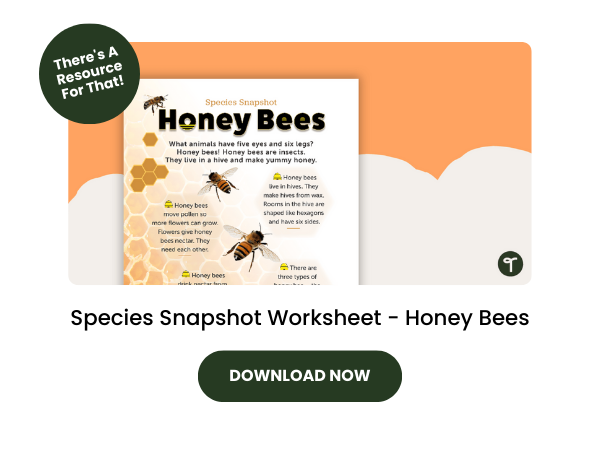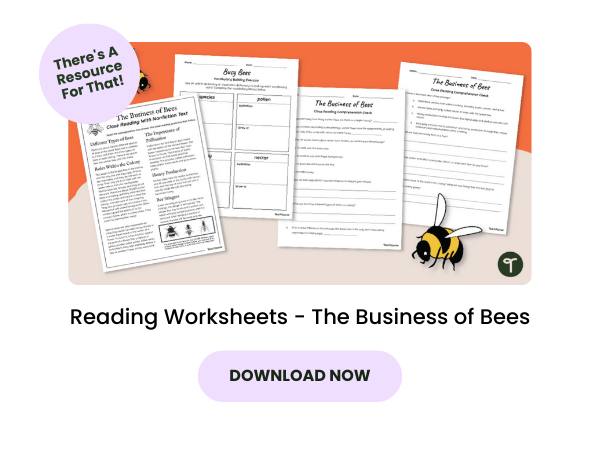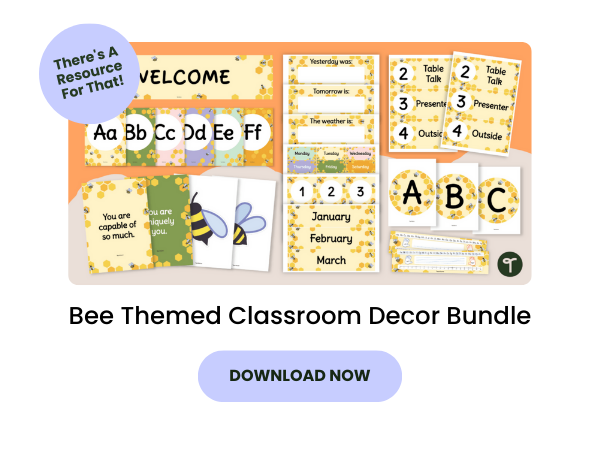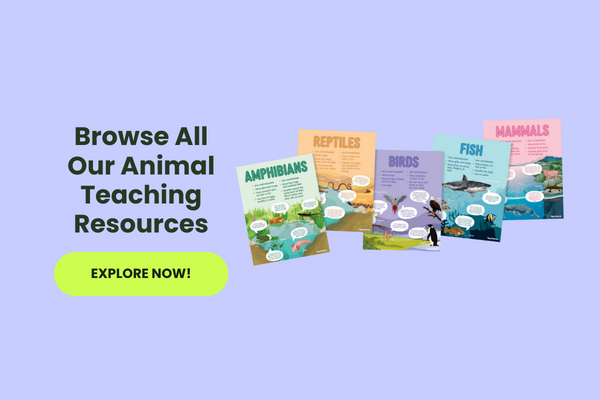Bees are essential to our natural world which can be translated into the classroom through some fun bee facts! Whether you’re starting a unit on pollination, sustainability or insects, bees bee-long in the mix.
The teacher team at Teach Starter has put together some incredible tidbits on these tiny yet mighty creatures to help you get started. Keep reading for bee facts, books about bees and how you can incorporate them into your lesson plans. We’re buzzing to share these with you!
Bee Facts for Kids
Did you know that bees are so important they have their own day named after them? The UN designated May 20 as World Bee Day to spread awareness of the importance of pollinators and to strengthen measures aimed at protecting bees.
Here are some un-bee-lievable bee facts to share with your students!
1. There are over 1500 different species of native Australian bees, varying in size from the large 24 mm yellow and black carpenter bees to the teeny-tiny 2 mm Quasihesma bees.
2. It is estimated that worldwide, there are about 20,000 species of bees! That’s a lot of buzzing.
3. Bees have existed for more than a whopping 100 million years.
4. Bees are essential pollinators because they transfer pollen between the female and male plant parts, allowing plants to produce seeds and fruit.
5. Honey bees have brains about the size of a sesame seed.
6. About 35 percent of invertebrate pollinators (especially butterflies and bees) face extinction globally.
7. Only female bees can sting! This is because female bees use the same mechanism to lay eggs as they do to sting.
8. Do you know someone named Melissa? If so, their name is derived from the Greek word for honey bee.
9. The ‘waggle dance’ is a way honeybees communicate with each other to direct nestmates on where to find the best source of food.
10. Bees use the sun as a compass giving them an amazing sense of direction.
11. Approximately 70 percent of 20,000 bee species around the world are solitary. This means that instead of living together in groups, female bees will build a nest, lay an egg and seal it off – never interacting with their offspring.
12. Honey bees live in hives (also known as colonies) and are divided into three groups: the queen, workers and drones.
13. The queen bee in a colony lays eggs and runs the entire hive. She can lay up to 2,500 eggs a day!
14. Worker bees are all female and have many jobs including building and protecting the hive and pollinating flowers while they forage for food.
15. A single worker bee might fly up to 800 kms in her lifetime! She will visit between 50 and 100 flowers during a foraging trip.
16. Bees have two stomachs. One stores nectar and processes it into honey, while the other is for eating.
17. Male bees are called drones and their job is to mate with the queen bee to ensure the continuation and survival of the colony.
18. About 90 percent of wild plants and 75 percent of global crops are dependent on animal pollination. That means some of the food you eat would not exist if it weren’t for pollinators!
19. 3,000 year old honey was found in King Tutankhamen‘s tomb in 1922. It was still edible!
20. Bees have four wings! The two on each side hook together to form a larger pair when they’re flying and then they unhook when they’re not.
21. The sound of a bee’s wings is what makes the classic buzz. They beat 11,400 times per minute!
22. Honey bees can fly at a speed of about 25 kms per hour. That’s one speedy insect!
23. Bees live in many homes besides hives. Bumblebees and honey bees often live in nests or hives but solitary bees nest in the ground. Some solitary bee habitats include wetlands, quarries, gravel pits and sand dunes.
24. Worker bees can create a new queen bee if the previous one dies. They will select a young larva and feed it special food called “royal jelly” to ensure it develops into a new fertile queen.
25. Ancient Greeks minted coins with bees on them.
26. Bees build their honeycombs with hexagonal cells. These shapes give them the most efficient means of storing honey and baby bees.
27. Honey bees have a sense of smell 50 times more powerful than a dog. This is because they have 170 odorant receptors.
28. The honey bee is the only insect that produces food eaten by humans. Honey bees make honey for the hive to eat during the winter months, but they’ll produce two to three times more honey than they need, allowing us to have a sweet bite!
29. The colour of honey is dependent on the flower types bees visit. Sometimes honey is very light coloured or dark like molasses.
30. Fermented honey is known as mead and was first produced in ancient China around 7,000 BCE.
How to Use These Bee Facts in the Classroom
- Make a bee hotel! While teaching your kiddos about solitary bees, try this bee house activity so students can take their creations home and give their buzzing friends a safe place to lay their eggs.
- Watch a video on how honey bees get their jobs with the help from National Geographic. This video will give your students some visual closeups of these amazing creatures.
- Get your class outside and plant bee-friendly flowers around the school! After checking in with your school’s admin, consider planting asters, alliums, bee balm, black-eyed susans, coneflowers, lavender, sunflowers and zinnias.
- After getting permission from parents first, have a honey tasting session. Try to collect a few different types of honey from the grocery store, the farmer’s market or a local farm and have your students first observe and describe the colour of the honey before comparing the tastes.
- Read a book about bees to your students or add some of these titles to diversify your classroom library:
- Explore My World: Honey Bees by Jill Esbaum
- What if There Were No Bees? by Suzanne Slade
- Give Bees a Chance by Bethany Barton
- Are You a Bee? by Judy Allen
- The Beeman by Laurie Krebs
- In the Trees, Honey Bees by Lori Mortensen
- Use this hexagons mini booklet to learn about this important geometric shape along with its role within a bee’s world.











Comments